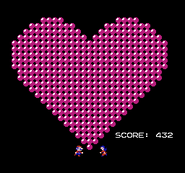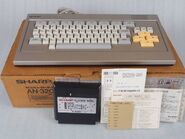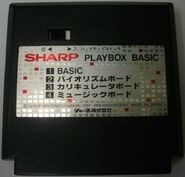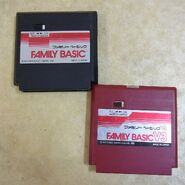|
Family BASIC (ファミリーベーシック Famirī Bēshikku) is an accessory for the Family Computer (Famicom) created by Hudson Soft, Nintendo, and Sharp Corporation.[1] It allowed users to create programs in the BASIC programming language, more specifically the NS-HuBASIC language which stands for Nintendo, Sharp, and Hudson Soft respectively. This accessory came with a specially designed cartridge and keyboard, similar in function to that of a Commodore computer of that era. There was also the Data Recorder peripheral which was sold separately. It was preceded by the nearly identical Playbox BASIC for the Sharp Game Television. Family BASIC V3 (ファミリーベーシックV3 Famirī Bēshikku Bui Surī) was released on February 21, 1985 as a stand-alone cartridge.[2]
The keyboard plugs into a 15-pin expansion port on the front of the Famicom and the Data Recorder plugs into the back of the keyboard labeled "SAVE" and "LOAD." If one does not have the Data Recorder or spare cassette tape (or finds cassette tape technology too inconvenient), one can just use the microphone and headphone jacks of a computer or similar device to record the analog signal coming from the keyboard with their preferred audio recording program and then play it back when the game is requesting data to be loaded.[3] Three games are compatible with the Data Recorder, including Excitebike, Mach Rider, and Wrecking Crew.
Release history[]

Playbox BASIC's Biorhythm Board
The Playbox BASIC and Family BASIC were both released in 1984 and came with NS-HuBASIC v1.0. Their initial retail price was the same as the Family Computer. While both included the music and calculator boards, the Playbox BASIC had a biorhythm board instead of a message board as the C1 TV already came with a message board.[4] In the Family BASIC, biorhythm does not have a separate board but can be performed by the computer's fortune telling function.[5] Soon after release, the v1.0 cartridges were replaced with v2.0A cartridges. Customers who bought the v1.0 versions could trade in their old ones for free and most did. As a result, v1.0 cartridges are now rare and Playbox BASIC ones are extremely rare as the only people who bought it were owners of the expensive C1 TV sets. V2.1A later came out with minor bug fixes. The Family BASIC cartridges for v1.0, v2.0A, and v2.1A have an identical black appearance.
Family BASIC V3 was sold a separate title with NS-HuBASIC v3.0 in red cartridges. It was marketed to people who already owned a previous version so it did not come with a keyboard and its manual served as an addendum to the previous v2.x manual. As a result of its narrow market, it sold poorly and is now rare. Unlike the previous versions, it did away with the message, calculator, and music boards to concentrate solely on programming. It had double the RAM capacity and came with pre-programmed mini-games.
Sprites[]
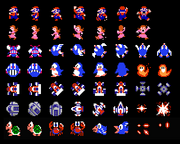
All the available sprites that can be used in Family BASIC
Many of the sprites and tilesets were taken directly from the Arcade Classics Series version of the Donkey Kong, Donkey Kong Jr., and Mario Bros. There are 16 animated sprites built-in. The following are the only sprites available for programmers:
- Mario - from his Mario Bros. design
- Lady - very similar to her Pinball design.
- Fighterfly
- Achilles - a bird-like creature, a palette swap of this sprite reappears in the Japanese version of VS. Pinball.[6]
- Nitanita - a smiley face
- Penpen - a penguin resembling the one from the slot windows from Pinball, this sprite will later be edited and reused for Hudson Soft's Famicom port of Binary Land.
- Fireball - from 100 m of Donkey Kong, this sprite will later be edited and reused for Challenger.
- Car
- Spinner - a rotational symmetric space ship
- Star Killer - the bulkier space ship
- Starship - the space ship with nacelles
- Explosion effects
- Shellcreeper
- Sidestepper
- Bird - from the Chain Scene of Donkey Kong Jr.
- Laser effects
It is possible to adjust the color of the sprites. The manual gives instructions on how to create Luigi or different colored enemies from the default sprites.
Programmable games in the v2.x manual[]
Before V3, there were no games available from the start. The v2.x manual gives instructions on how to create eight sample games.[7]
- Knight - each player controls a chess knight on a chess board. Any spot that has been landed upon becomes unavailable. The aim is to trap the opposing player. It is similar to other "square-removal" chess variants that utilize the knight's tour.[8][9]
- Super Memory - a memory game similar to Simon.
- UFO - a shooter where the player controls the Starship and faces off against a lone Fighterfly that shoots back. This game comes with the Data Recorder's cassette.
- Route 66 - an endless top-down driving game like Speed Race and Color TV-Racing 112.
- Type Master - a typing game
- Turtle - horse betting but on Shellcreepers
- Card - a card matching game similar to N-Mark Spade Panel
- Sample program 8 - a turn-based chase game where Penpen has to grab flags while evading a Nitanita. The manual insists that this is not a game but a tech demo and leaves it unnamed.
Other official programmable games[]
Four official guidebooks were published to support Family BASIC owners. Each came with a cassette loaded with programs, including the games found in the books, that was also available separately.
- ファミリーベーシックで遊ぼう! (Let's Play with Family BASIC!)
- ファミリーベーシックで遊ぼう!おもしろゾーン20 (Let's Play with Family BASIC! Fun Zone 20)
- ぼくとわたしのファミリーベーシック教室 (I and My Family BASIC Classroom)
- ファミリーベーシックで歌おう!ミュージックワールド (Let's Sing with Family BASIC! Music World)
In addition, Hudson Soft released three cassettes with games on them through Shōnen Media (少年メディア), a Shōnen Jump related publication.
V3 mini-games[]
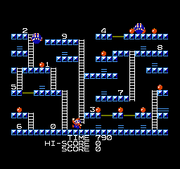
Mario World
Family BASIC V3 came with four mini-games:
- Game 0 "Heart": There is an outline of a heart that can be filled by speaking or breathing into microphone of controller 2. When done, Mario and Lady will come together. This is reproduction of a cutscene from Sheriff, Nintendo R&D1's 1979 arcade game.
- Game 1 "Penpen Maze": The player controls Penpen on a grid. The object is to collect numbers in order while avoiding two Sidesteppers. Penpen starts off with three traps that can temporarily stun the Sidesteppers.
- Game 2 "Mario World": Mario has to collect numbers sequentially and apples through a single screen of platforms, ladders, and springs while avoiding the two Nitanitas. However, collecting all the items does not end the game. The Time Limit will simply run out, forcing a Game Over.[10]
- Game 3 "Star Killer": This is an endless space shooter on a wraparound screen for 1 or 2 players controlling Star Killer and Starship respectively. Enemies include Spinners, Fighterflies, Fireballs, and Achilleses.
Appearances in Nintendo games[]
In WarioWare, Inc.: Mega Microgame$! and WarioWare, Inc.: Mega Party Game$!, 9-Volt's microgame Family Basic includes the Family BASIC keyboard, where the objective is to type in the requested numbers or letters.
Gallery[]
External links[]
References[]
- ↑ https://nerdlypleasures.blogspot.com/2021/03/family-basic-putting-computer-into.html
- ↑ https://themushroomkingdom.net/fb3.shtml
- ↑ https://www.youtube.com/watch?v=__9VYaKMwQI&t=12m45s
- ↑ https://web.archive.org/web/20190915234033/http://www.sara.to/sigure/game/g12/index.html
- ↑ https://youtu.be/14l2nnT6-bg?t=219
- ↑ VS. Pinball gameplay
- ↑ https://www.youtube.com/watch?v=ir8jM3otL5w
- ↑ https://www.chessvariants.com/other.dir/kchase.html
- ↑ http://indigo.ie/~gerryq/Joust/Joust.htm
- ↑ https://www.youtube.com/watch?v=0or6KaR6N6k


